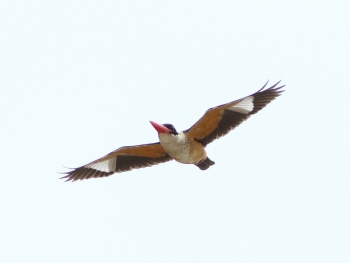Alternative name: Black-capped Purple Kingfisher
- Halcyon pileata
Identification
Size 28cm (11 in)
Black head and rufous belly and flanks separated by white throat and collar.
Purple-black upperparts.
Bill bright red, with dark base
Juveniles are duller, have a buffy collar, dusky scaling on breast and a brownish-orange bill.
Flight
In flight shows conspicuous white patch at base of primaries.
Similar Species
White-throated Kingfisher differs in lacking the white collar on the rear neck, brown on head con-color and connected with the flanks, brown on part of the wing coverts, lacking the darker base of the bill, etc. but shares the white throat and the white patch on wings.
Distribution
Breeds in Indian subcontinent, Myanmar, China and Korea.
Winters throughout southeast Asia to Sumatra, Borneo, Sulawesi and the Philippines.
Uncommon winter visitor, and passage migrant in Singapore.
Taxonomy
This is a monotypic species[1].
It forms a superspecies with Grey-headed Kingfisher.
Habitat
Mostly found in the lowlands, in mangroves, sea coasts, rice fields, forest edges, forested river courses.
Behaviour
Territorial in its wintering quarters; it is aggressive and often displaces the resident White-throated Kingfisher. Shy.
Diet
Coastal birds feed mainly on fish, moving on to the sandflats to hunt for crabs at low tide.
Inland birds concentrate more on insects, such as dragonflies, locusts, crickets, beetles, bees and wasps. Sometimes they will take frogs and reptiles.
Breeding
Starts breeding in April in India, from April to May in Burma, in June in Korea. The nest is placed in a self-dug tunnel in an earth mound, a cutting or a stream bank. Lays 4-5 eggs.
Vocalisation
Not as vocal as White-throated Kingfisher.
Has a unique ringing cackle; kikikikikiki.
References
- Clements, J. F., T. S. Schulenberg, M. J. Iliff, S. M. Billerman, T. A. Fredericks, J. A. Gerbracht, D. Lepage, B. L. Sullivan, and C. L. Wood. 2021. The eBird/Clements checklist of Birds of the World: v2021. Downloaded from https://www.birds.cornell.edu/clementschecklist/download/
- Del Hoyo, J, A Elliot, and J Sargatal, eds. 2001. Handbook of the Birds of the World. Volume 6: Mousebirds to Hornbills. Barcelona: Lynx Edicions. ISBN 978-8487334306
- Birdforum Member observations
- Woodall, P. F. and G. M. Kirwan (2020). Black-capped Kingfisher (Halcyon pileata), version 1.0. In Birds of the World (J. del Hoyo, A. Elliott, J. Sargatal, D. A. Christie, and E. de Juana, Editors). Cornell Lab of Ornithology, Ithaca, NY, USA. https://doi.org/10.2173/bow.blckin1.01
Recommended Citation
- BirdForum Opus contributors. (2025) Black-capped Kingfisher. In: BirdForum, the forum for wild birds and birding. Retrieved 13 May 2025 from https://www.birdforum.net/opus/Black-capped_Kingfisher
External Links
GSearch checked for 2020 platform.






